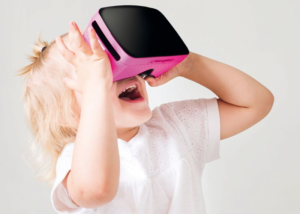We see it increasingly often. Children who can barely walk or barely say their first words, engrossed in front of a smartphone screen or operating a tablet with far greater fluency than many adults. Children’s access to digital technologies is a topic of equal parts interest and controversy.
Many adults, attracted by the time and peace of mind it gives them to keep the little ones entertained, are in favour. Others, concerned about the effects on children’s social and cognitive development, are more reluctant. This social debate also spills over into the scientific and educational world. But what does the evidence say? How do you see the use of digital technology and early childhood? Can it help children’s education? And of the most vulnerable? If so, under what conditions and circumstances? How are we doing it?
A dialogue between scientific evidence and public policies
The study Early childhood in the age of digital transformation. An Ibero-American Perspective attempts to respond to all these concerns. The publication, presented by the Organisation of Iberoamerican States for Education, Science and Culture (OEI) with the support of the Spanish Agency for International Development Cooperation (AECID), is an interesting dialogue between scientific evidence and public policy is an interesting dialogue between scientific evidence and public policies. Its objective: to produce evidence to inform public policy on the impact of technology and digitalisation on early childhood development.
It is divided into two main parts: a synthesis of updated knowledge generated from scientific evidence and a description of the Ibero-American reality. Thus, through a comprehensive analysis involving leading experts in neuroscience, paediatrics, psychology and pedagogy, the study focuses on the influence of technology in early childhood in two fundamental areas: family and school. It includes the results of the most recent research on the subject, with special emphasis on the impact on the neurological, cognitive, social and psycho-motor development of girls and boys. The report concludes with a description and analysis of public policy responses in the Ibero-American region to the relationship between digital transformation and early childhood.
The voices of the academia

What does academia tell us about the influence of digital technology on early childhood development? For the field of neuroscience offers us certain signs of the importance of the first four years as an opportunity for neurodevelopment. It also tells us that well-planned and well-used digital technologies can make a real contribution to education and learning, often enabling access and making education more inclusive and equitable.
The chapter on cognitive development warns that during the first two years it should be used with great caution because, in addition to being a very important period, there is still a lack of research and evidence. However, and once again in a planned way, technology offers us pedagogical content that can be of great use, especially for vulnerable or atypically developing populations, who could thus have access to richer interactions.
Technology can also be a great window of opportunity for children’s socio-emotional development. Of course, the importance of socialisation, parents, families… cannot and should not be replaced by technology; however, it can be a good complement when it comes to favouring certain psychomotor and socio-emotional aspects.
The role of families and schools is extremely important and, in fact, a good relationship between these two institutions can be a very good predictor of students’ academic performance. The study therefore suggests the need to foster this relationship, and here technology can be a channel, a facilitator.
In conclusion:
- Critical aspects of neurological, cognitive, social, social, emotional and motor development take place in the early years.
- With proper planning, limited time, clear objectives and appropriate content, the use of digital technologies in early childhood can be beneficial for the development of all dimensions, taking as a precaution that access is limited during the first two years of life.
- Appropriate use of digital technologies can have special benefits for vulnerable or underdeveloped populations.
- Technological play can be a space of opportunity, but we must be aware that it should not replace traditional play, where experiences have a unique value.
- The time and quality of interactions with others and with various objects must be safeguarded.
- Adult supervision is crucial in this age group for the beneficial use of digital technologies.
- There must be training for both families and educators that involves technological, but also didactic and pedagogical aspects. Such training will allow both family and school to interact in a complementary and constructive way.
- Access to R&D must be ensured for all.
The reality of public policy

The second part of the study collects and analyses information on the reality of digital transformation and early childhood in 19 Latin American countries. It does so on the basis of four dimensions. What are these dimensions and what have been the most notable developments observed in each of them?
1) The structure and development of the early childhood education system. This dimension aims to find out how early childhood and digital transformation are taken into account in all the education systems analysed. Starting from a real knowledge of what is there.
What does the evidence say? Digital skill is an issue that should be a priority, not only because it is part of our lives, but also because it impacts on the quality of our lives, especially for early childhood children, who are developing critical aspects. There is therefore a demand where their interactions with digital technologies need to be planned, with clear objectives and appropriate content.
What does the reality of the countries analysed tell us? All countries had early childhood curricula regulation; however, digital skill was very weakly present in the curricula, being present in only 50% of the countries. The development of content associated with digital technologies is also very limited (only 7 out of 19 countries report developing it).
2) School organisation in early childhood and digital technologies. How school spaces are organised in early childhood and the place of technology within these spaces.
What does the evidence say? The evidence is strong in identifying that there must be clarity in the selection of material to be used with early childhood children. The content, timing, objectives and activities chosen will be decisive in ensuring a positive impact of the interaction with digital technologies.
What does the reality of the countries analysed tell us? All the spaces (toilet, nutrition, play, psycho-motor skills…) are very well differentiated; but, as in the previous case, there is a lack of a digital workspace for the children. Only a few countries (8 out of 19) establish, through regulations, requirements for technological equipment, use of educational software and/or didactic resources for early childhood in schools.
3)Policies and programmes developed in early childhood and digital technology. Check the proposals that have been made, from each country, once the COVID-19 pandemic occurs.
What does the evidence say? Access to internet connection is vital to ensure equity and quality in early childhood education. The same applies, and very much so, to teacher training in ICT, the promotion of the use of new technologies throughout the education community and the improvement of technological equipment.
What does the reality of the countries analysed tell us? Under the circumstances, countries have implemented extraordinary continuing education programmes that incorporate the use of technology. The main barrier reported by countries to continuing with curricular content has been access to an internet connection itself. It is, however, relevant and significant that 47% of the countries have carried out studies on the use of digital technologies for the development of educational activities, as this shows that they are or want to be aware of the challenges to be addressed and will work on it in the coming years.
Notable experiences. To publicise innovative experiences that have taken place in the countries analysed. Thus, innovative, replicable and sustainable experiences such as Cuentos de Panamá, Viajes Culturales de Fin de Semana, Crecer con Cariño or Cuentos que Viajan stand out. The study highlights the high capacity of schools to adapt and reinvent themselves in order to continue to guarantee the right to education for early childhood children.






